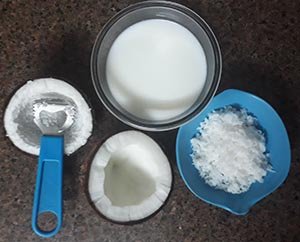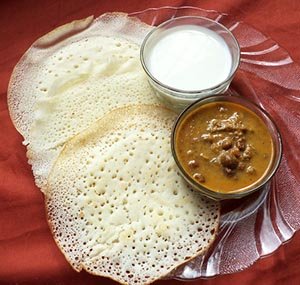Coconut milk Nutrition facts
Coconut milk is a sweet, milky-white liquid, extracted from the fresh coconut kernel. Green, but mature, coconuts are employed either manually or mechanically for this purpose.
Many households in South Asia and Southeast Asia extract coconut milk instantly for ready use in rice, stews, curries, sweets, desserts, and puddings.
 |
| Fresh Coconut milk. |
The coconut palm from where green coconuts are obtained is an unbranched, erect, tall-growing plant in the Palmaceae family of palm trees. Scientific name : cocus nucifera.
Coconut milk has a special flavor and sweet taste, which is attributed to its high fat and natural sugars. Its composition, however, greatly depends on the amount of water used for its extraction, affecting significant moisture and fat content. For example, coconut milk obtained from single-stage extraction, without added water, is thicker, sweeter, and has a more intense flavor.
Processing methods
Only green but mature coconuts are employed for making milk. Young, tender, and dry coconut (copra), are unsuitable for pressing as their kernel is either just too soft and jelly-like in the case of unripe nuts or dry and oily in copra.
The raw coconut is husked, cleaned, and broken open to separate its kernel from the shell while the coconut water was collected for future use. Some prefer to scrape off the brown, thin, outer skin over the kernel surface.
Wash the meat thoroughly and grate using a manual grater. The grated coconut meat is then mixed in Coconut water and allowed to stand in a water bath for 10-15 minutes. Add hot water to this semi-liquid mixture and allow to stand for 10 minutes.
The mixture is then pressed and filtered to remove the solid residue and recover the milk. The milk is pasteurized and allowed to assume room temperature before use in recipes.
Health benefits of Coconut milk
Cream and milk of coconut carry moderate levels of calories unlike its other products like oil and dry kernels, which are denser sources of energy. 100 ml of regular coconut milk contains 230 calories.
The sweet flavor of coconut milk comes from sucrose, a disaccharide found predominantly in plant sugars. Though sucrose has a moderately high glycemic index, research studies suggest that coconut sugar is better than table sugar in terms of overall health benefits.
Coconut milk is a better source of iron, phosphorus, magnesium, and zinc than cow's milk but low in calcium.
Despite its high saturated fat composition, coconut milk is a rich source of medium-chain triglycerides (MCT) such as lauric acid. MCTs absorb passively and enter the blood system in the gut without intermediary transport channels.
Bioactive enzymes in fresh coconut milk help in smooth digestion, and bowel movements, and aid in better absorption of minerals and fat-soluble vitamins.
Several research studies suggest that coconut fats help reach early satiety and increase blood HDL/total cholesterol levels. The major factor responsible for the hypolipidemic effect of coconut protein is the high content of L-arginine.
Lauric acid, and other MCT's absorbed passively into the bloodstream, thus saving energy and bringing a quick sense of satiety. The beneficial effects of fats in coconut milk are strongly commended by some nutrition scientists like Mary Gertrude Enig who is among the frontline advocators of health benefits of saturated fats. When consumed in moderation over a period, saturated fats, mainly medium-chain triglycerides, may help reduce body weight and may cut down the risk of atherosclerosis and CAD.
Coconut milk contains a small amount of vitamin E and other tocopherols. 100 g of fresh oil is composed of 0.15 mcg of vitamin E.
Product types:-
Light coconut milk: It is the most diluted form of coconut milk. The product was obtained from filtering after further dilution of coconut milk with water.
Regular coconut milk: It is the dilute emulsion of grated coconut meat in water with soluble and suspended solids.
Coconut cream: It is the first liquid extracted from matured coconut meat without the addition of coconut water/water.
Concentrated coconut cream: It is the evaporated product obtained after the partial removal of water from coconut cream.
| Principle | Nutrient Value | Percent of RDA |
|---|---|---|
| Energy | 230 Kcal | 11.5% |
| Carbohydrates | 5.54 g | 4% |
| Protein | 2.29 g | 4% |
| Total Fat | 23.84 g | 119% |
| Cholesterol | 0 mg | 0% |
| Dietary Fiber | 2.2 g | 6% |
| Vitamins | ||
| Folates | 16 µg | 4% |
| Niacin | 0.760 mg | 5% |
| Pyridoxine | 0.033 mg | 2.5% |
| Riboflavin | 0 mg | 0% |
| Thiamin | 0.026 mg | 2% |
| Vitamin-A | 0 IU | 0% |
| Vitamin-C | 2.8 mg | 4.6% |
| Vitamin-E | 0.15 mg | 1% |
| Electrolytes | ||
| Sodium | 15 mg | 1% |
| Potassium | 263 mg | 5.6% |
| Minerals | ||
| Calcium | 16 mg | 1.6% |
| Iron | 1.64 mg | 20.5% |
| Magnesium | 37 mg | 9% |
| Phosphorus | 100 µg | 14% |
| Zinc | 0.67 mg | 6% |
Selection and Storage
Coconut milk is imported in the United States, mainly from Thailand and Malaysia. Ready to use coconut milk in cans, tetra-packs can be readily available in groceries and supermarkets. One can find full cream, fortified, hybrid with cow milk in these stores.
Coconut milk tends to spoil early because of the high bioactive enzymes in it. Use freshly prepared milk immediately or else store it in the refrigerator at home for extended use.
Culinary uses
Coconut and its products, including milk, play an important role in many traditional cuisines of South and Southeast Asia. Almost all households in the Southern part of India, Sri Lanka, Thailand, Malaysia, Singapore, Indonesia, and the Philippines use coconut milk in the preparation of dishes.
The use of coconut cream and milk is on the rise as major sources of dietary fat in substitute for dairy and animal fats in the United States and Europe.
Here are some serving tips
< |
| Appam, kadala curry and coconut milk. Photo credit: devika |
Called kakang gata (first extraction) in Filipinos, coconut cream is used in a variety of recipes.
Coconut rice is a staple food in many regions of East and Southeast Asian countries and in West Africa and Nigeria. Nasi lemak is a fragrant rice dish cooked in coconut milk and pandan leaf in Malaysia, where it is considered the national dish. It is served along with roasted peanuts, sambal and boiled egg as accompaniments.
Its high-fat content and creamy taste add a special flavor to bakery items like cookies, chocolates, creams, spread, etc.
In Thailand, Kluai buat chi (กล้วยบวชชี- banana in coconut milk) is a dessert wherein bananas are cooked in a mixture of coconut milk and coconut cream.
In South India, coconut milk is one of the essential items in curries; be it vegetables or fish.
Bubur cha cha is another sweet dish in Malaysian and Singapore. It is prepared using cooked pearled sago, yam (sweet potatoes) and bananas in coconut milk with pandan leaves, sugar, and salt as flavorings.
Safety profile
Coconut milk, like that of coconuts, is a very safe food item for consumption, including by infants and pregnant women. Allergic reactions and intolerance to coconut milk as food are rare. (Medical Disclaimer).
Also read ≻≻-
≻≻- Coconut nutrition facts.
≻≻- Coconut water nutrition facts.
≻≻-Back to Home page from Coconut milk nutrition facts and health benefits.
Further Resources:
- Philippine Coconut Authority.
The Weston A. Price Foundation- A new look at coconut oil.
Coconut Research center- PDF (opens in new window)